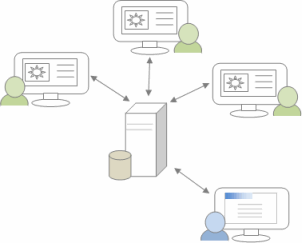
In this topic
NVivo for Windows is a desktop application that lets users organize, analyze and visualize information—anything from PDFs and Word documents to web pages, video and audio recordings, or data from Twitter, Facebook and online surveys.

Users can code to organize their material by topic and run queries to uncover trends and emerging themes. The visualization tools let them create charts or models to present and clarify their discoveries.
On its own, NVivo supports basic teamwork, allowing users to track and analyze changes to a project based on user profiles. Team members can also work on individual projects and then import them into a master project—but they cannot work on the same project at the same time. This is where NVivo Server can assist.
NVivo Server is a server-side application that manages NVivo projects in a centralized database repository—allowing users to work on the same project at the same time.

As server administrator, you can use the NVivo Server Manager to:
Manage licenses and user access to the server
Monitor projects and user connections
Perform basic maintenance tasks such as backing up, repairing and restoring projects
More complex maintenance tasks can be performed using SQL Server Management Studio—for example, migrating projects from one NVivo Server to another.
NVivo Server can host projects in NVivo 10 for Windows and NVivo 9 formats, however projects in NVivo 10 format cannot be opened with the NVivo 9 client software. Everyone working in a shared project should be using the same version of NVivo for Windows client software to connect to the server. Refer to Supporting connections from clients running different versions of NVivo for more information.
NVivo Server 10 and NVivo Server 10 R2 permit connections from any version of the NVivo 10 for Windows and NVivo 9 client software and can host projects in all NVivo 10 for Windows and NVivo 9 formats. All users, who are working together in a shared project, should be using the same version of the NVivo client.
NVivo Server cannot host NVivo 10 for Mac projects and the NVivo 10 for Mac clients cannot connect to NVivo Server.
The NVivo client provides backward compatibility—if a later version of the NVivo client attempts to open a project in an earlier format (for example, the NVivo 10 for Windows client attempts to open an NVivo 9.2 project), the user is prompted to convert the project to the later format. The original project is not changed; instead a converted copy of the project is created on the server.
The NVivo client does not provide forward compatibility—the user cannot open a project with a later format (for example, the NVivo 9.2 client cannot open an NVivo 10 for Windows project).
In this example (below), the NVivo server is hosting projects in both NVivo 10.0 for Windows and NVivo 9.2 formats:

As NVivo Server enables multiple users to access and work on each centrally stored NVivo project—it needs to be installed on a server that is connected to a network.
We recommend that client connections to NVivo Server are made via a low-latency 100 Mbps (or faster) network.
If you want users to access server projects via an Internet connection, you could use 'thin client' or VDI (Virtual Desktop Interface) technologies, such as:
Microsoft Remote Desktop Services
Citrix XenApp
Quest vWorkspace
The QSR Technical Resource Center provides instructions for deploying the NVivo client using VDI technologies.
NVivo Server can help your organization to:
Streamline project management—users can store all NVivo projects in a central database repository on NVivo Server. You can monitor, maintain, backup and keep track of all projects in one secure location.
Promote collaboration—team members can work in the same project at the same time, and see each other's updates as they work. To speed things up, large sources such as datasets can be analyzed by multiple researchers at once.
Enhance security—role-based permissions cater for different levels of server access. Specified users (or groups) can create new projects while others can only view and edit existing projects. In individual projects, Project Owners can assign user roles to control access. Users access the server using authenticated Windows login credentials.
Work with small or large projects—NVivo Server projects, unlike standalone NVivo 10 for Windows projects, can be larger than 10GB—project size is only limited by available storage capacity.
Setup and manage user access with the easy-to-use browser-based NVivo Server Manager.
The main difference between NVivo Server 10 and NVivo Server 10 R2 is the database component that is installed and used to host projects:
| Release | Version of SQL Server installed |
| NVivo Server 10 | SQL Server 2008 R2 Standard Edition SP2 |
| NVivo Server 10 R2 | SQL Server 2012 Standard Edition SP1 |
There are also some differences in system requirements and location of installed files. However there are no feature differences between NVivo Server 10 and NVivo Server 10 R2, so if you already have NVivo Server 10 installed there is no need to switch to NVivo Server 10 R2.
If you currently have NVivo Server 9 and want to upgrade your software, you should contact QSR International to discuss your upgrade options.